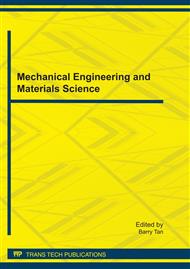[1]
W. E. Fry, S. B. Goodwin, J. M. Matuszak, L. J. Spielman, M. G. Milgroom, and A. Drenth, Population genetics and intercontinental migration of Phytophthora infestans, Annu. Rev. Phytopathol., 30: 107-129, (1992).
DOI: 10.1146/annurev.py.30.090192.000543
Google Scholar
[2]
S. B. Goodwin, L. J. Spielman, J. M. Matuszak, S. N. Bergeron, and W. E. Fry, Clonal diversity and genetic differentiation of Phytophthora infestans populations in northern and central Mexico, Phytopathology, 82: 955-961, (1992).
DOI: 10.1094/phyto-82-955
Google Scholar
[3]
A. Castellani, Further researches on the long viability and growth of many pathogenic fungi and some vacteria in sterile distilled water, Mycopathol. Mycol. Appl., 20: 1-6, (1963).
DOI: 10.1007/bf02054872
Google Scholar
[4]
R. S. Brilhante, C. S. Cavalcante, F. A. Soares-Junior, A. J. Monteiro, E. H. Brito, and R. A. Cordeiro, Evaluation of Microsporum canis in different methods of storage, Med. Mycol. 42: 499-504, (2004).
DOI: 10.1080/13693780410001712052
Google Scholar
[5]
M. G. Feng, and L. Hua, Factors affecting the sporulation capacity during long- term storage of the aphid-pathogenic fungus Pandora neoaphidis grown on broomcorn millet, FEMS Microbiol. Lett., 245: 205-211, (2005).
DOI: 10.1016/j.femsle.2005.03.015
Google Scholar
[6]
R. Ferreti-de-Lima, and C. de—Moraes-Borba, Variability, morphological characteristics and dimorphic ability of fungi preserved by different methods, Rev. Iberoam Micol., 18: 191-196, (2001).
Google Scholar
[7]
L. Krizkova, and J. Balan, Prolonged preservation of Oomycetes and predacious Fungi imperfecti under paraffin oil, Folia Microbiol., (Praha) 20: 351-353, (1975).
DOI: 10.1007/bf02878118
Google Scholar
[8]
A. M. da Silva, C-de-M. Borba, and P. C. de Dliveiro, Viability and morphological alterations of Paracoccidioides brasiliensis strains preserved under mineral oil for long periods of time, Mycoses, 37: 165-169, (1994).
DOI: 10.1111/j.1439-0507.1994.tb00295.x
Google Scholar
[9]
K. Gindro, and R. Pezet, Effects of long-term storage at different temperatures on conidia of Botrytis cinerea Pers, Fr. FEMS Microbiol Lett., 204: 101-104, (2001).
DOI: 10.1111/j.1574-6968.2001.tb10870.x
Google Scholar
[10]
T. Bunse, and G. K. Steigleder, The preservation of fungal cultures by lyophilisation, Mycoses, 34: 173-176, (1991).
Google Scholar
[11]
M. J. Ryan, P. Jeffries, P. D. Bridge, and D. Smith, Developing cryopreservation protocols to secure fungal gene function, Cryo Letters, 22: 115-124, (2001).
Google Scholar
[12]
L. Homolka, L. Lisa, and F. Nerud, Viability of basidiomycete strains after cryopreservation: comparison of two different freezing protocols, Folia Microbiol., (Praha) 48: 219-226, (2003).
DOI: 10.1007/bf02930959
Google Scholar
[13]
P. M. Stockdale, D. Smith, and C. K. Campbell, The maintenance and preservation of fungi, In: Medical Mycology: A Practical Approach eds. by E. G. V. Evans, M. D. Richardson, 1989, pp.187-200. Eynsham, Oxfod, England, IRL Press.
Google Scholar
[14]
S. B. Goodwin, and W. E. Fry, Global migration of Phytophthora infestans, Phytopathogy, 82: 955-961, (1991).
Google Scholar
[15]
H. R. Hohl, and K. Iselin, Strains of Phytophthora infestans with the A2 mating type behaviour, Trans. British Mycol. Soc., 83: 529-530, (1984).
DOI: 10.1016/s0007-1536(84)80057-1
Google Scholar
[16]
M. N. Kato, N. Sato, K. Takahashi, and T. Shimanuki, Yearly changes of frequency and geographical distribution of A2 mating type isolates of Phytophthora infestans in Japan from 1987 to 1993, Ann. Phytopatholo. Soc. Japan, 64: 168-174, (1998).
DOI: 10.3186/jjphytopath.64.168
Google Scholar
[17]
J. P. Day, R. A. M. Wattier, D. S. Shaw, and R. C. Shattock, Phenotypic and genotypic diversity in Phytophthora infestans on potato in Great Britain, 1995-98, (2004).
DOI: 10.1111/j.0032-0862.2004.01004.x
Google Scholar
[18]
Z. M. Zhang, Y. Q. Li, S. M. Tian, J. H. Zhu, J. Wang, and B.F. Song, The occurrence of potato late blight pathogen (Phytophthora infestans) A2 mating type in China, J. Agricul. Univ. Hebei, 19: 65~69, (1996).
Google Scholar
[19]
X. Q. Zhu, X. B. Che, L. Y. Guo, and Y. H. Wang, Mating type of Phytophthora infestans from six province (cities) in China and their sensitivity to several fungicides, Plant Protection, 30: 20~23, (2004).
Google Scholar
[20]
G. H. Jin, Y. M. Bai, X. M. Sun, S. K. Yuan, and W. H. Lu, Testing for A2 mating type of Phytophthora infestans in Potatoes of Heilongjiang, Chinese Potato J., 20:212~214, (2006).
Google Scholar
[21]
G. N. Little, and M. A. Gordon, Survival of fungus cultures maintained under mineral oil for twelve years, Mycologia, 59: 733-736, (1967).
DOI: 10.2307/3757105
Google Scholar
[22]
C-de-M. Borba, A. M. da Silva, and P. C. de Oliveiro, Long-time survival and morphological stability of preserved Sporothrix schenckii strains, Mycoses, 20: 351-353, (1992).
DOI: 10.1111/j.1439-0507.1992.tb00843.x
Google Scholar
[23]
A. M. Borman, A. Szekely, C. K. Campbell, and E. M. Johnson, Evaluation of the viability of pathogenic filamentous fungi after prolonged storage in sterile water and review of recent published studies on storage methods, Mycopathologia, 161: 361-368, (2006).
DOI: 10.1007/s11046-006-0023-z
Google Scholar
[24]
B. S. Kim, Y. R. Chung, and G. Y. Cho, Fitness comparison of Phytophthora infestans isolates resistant and sensitive to metalaxyl and control of the disease by dimethomorph or chlorothalonil, Korean J. Plant Pathol., 9: 31-35, (1993).
Google Scholar


